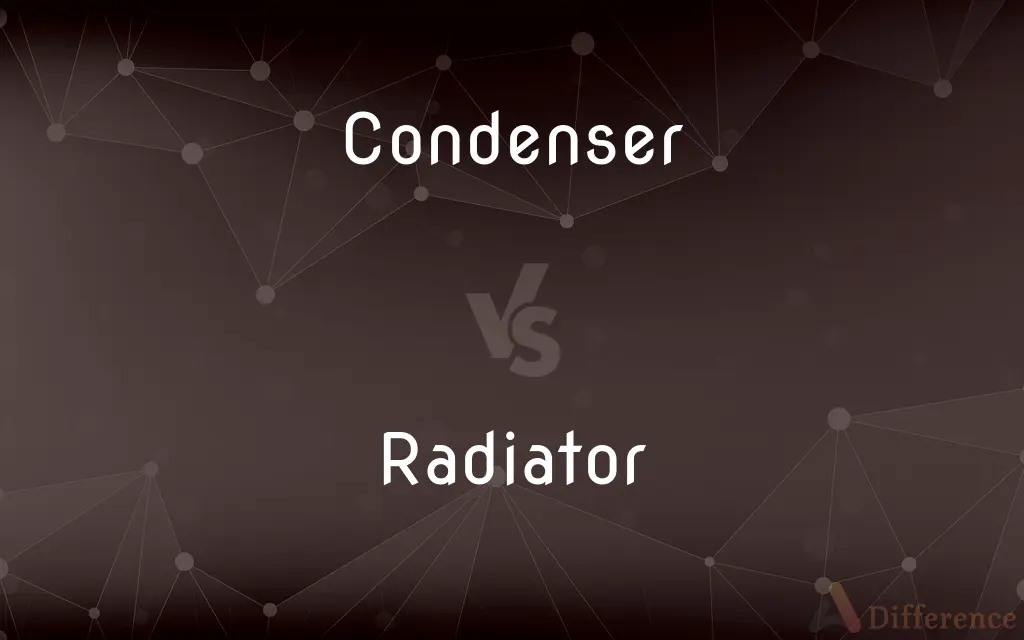Condenser vs. Radiator — What's the Difference?
Edited by Tayyaba Rehman — By Urooj Arif — Updated on March 14, 2024
A condenser cools and condenses refrigerant vapor in AC systems, while a radiator dissipates heat from engine coolant in vehicles, serving distinct cooling functions.

Difference Between Condenser and Radiator
Table of Contents
ADVERTISEMENT
Key Differences
Condensers are key components in air conditioning and refrigeration systems, functioning to cool down and condense refrigerant vapor back into a liquid. This process is crucial for the refrigeration cycle, allowing the system to release heat absorbed from the interior space to the outside environment. On the other hand, radiators are primarily found in vehicles and are designed to dissipate heat from the engine coolant to the air, preventing the engine from overheating by transferring the absorbed heat from the engine to the atmosphere.
The operation of a condenser involves the refrigerant vapor entering the condenser coils at a high temperature and pressure. As the vapor cools, it condenses into a liquid form, releasing its heat to the surrounding air, often with the aid of a fan to enhance air flow. In contrast, a radiator circulates hot coolant through its tubes and fins, where air flow, either from the vehicle’s motion or a fan, carries away the heat, allowing the cooled coolant to return to the engine for another cycle.
Condensers are typically part of a closed loop system in air conditioners and refrigerators, where they work in tandem with compressors, evaporators, and expansion devices to complete the refrigeration cycle. Radiators, however, are part of the vehicle's cooling system, which includes the water pump, thermostat, and coolant, forming an open system that interacts with the engine's combustion process.
The efficiency of a condenser is measured by its ability to reject heat from the refrigerant to the environment, which is crucial for the effectiveness of the cooling cycle in AC units and refrigerators. The efficiency of a radiator is determined by its capacity to remove heat from the engine coolant, with larger surface areas and enhanced airflow contributing to better cooling performance.
Selecting between a condenser and a radiator depends on the application: condensers are essential for air conditioning and refrigeration systems to cool and condense refrigerant, while radiators are crucial for vehicle cooling systems to dissipate engine heat and prevent overheating.
ADVERTISEMENT
Comparison Chart
Function
Cools and condenses refrigerant vapor into liquid.
Dissipates heat from engine coolant.
Application
Air conditioning and refrigeration systems.
Vehicle cooling systems.
Operation
Refrigerant vapor cools and condenses on the coils.
Hot coolant transfers heat to air through tubes and fins.
System
Part of a closed refrigeration cycle.
Part of an open system interacting with engine combustion.
Efficiency
Measured by heat rejection from refrigerant.
Depends on heat removal from coolant, improved by airflow.
Key Components
Coils, refrigerant, and often a fan for air flow.
Tubes, fins, coolant, and often a fan for air flow.
Compare with Definitions
Condenser
Integral to refrigeration and AC systems.
The AC unit's condenser was located outside to efficiently expel heat.
Radiator
Crucial for vehicle engine cooling.
The car's radiator prevented the engine from overheating during long drives.
Condenser
Condenses refrigerant vapor into liquid.
The refrigeration cycle relied on the condenser to turn the high-pressure vapor into a liquid.
Radiator
Dissipates heat from the coolant to the air.
As the coolant passed through the radiator, it lost heat to the surrounding air.
Condenser
Efficiency crucial for cooling effectiveness.
The condenser's efficiency in rejecting heat determined the air conditioner's cooling capacity.
Radiator
Part of the vehicle's cooling system.
The radiator worked with the water pump and thermostat to regulate engine temperature.
Condenser
Releases absorbed heat to the environment.
The heat from the indoor space was released outdoors by the condenser.
Radiator
Uses airflow to enhance cooling.
The fan kicked in to increase airflow through the radiator when the vehicle was stationary.
Condenser
Works in a closed loop with other components.
The condenser functioned alongside the evaporator and compressor in the cooling system.
Radiator
Designed for efficient heat removal.
The radiator's large surface area maximized heat dissipation from the coolant.
Condenser
An apparatus or container for condensing vapour.
Radiator
Radiators are heat exchangers used to transfer thermal energy from one medium to another for the purpose of cooling and heating. The majority of radiators are constructed to function in cars, buildings, and electronics.A radiator is always a source of heat to its environment, although this may be for either the purpose of heating this environment, or for cooling the fluid or coolant supplied to it, as for automotive engine cooling and HVAC dry cooling towers.
Condenser
A lens or system of lenses for collecting and directing light.
Radiator
A heating device consisting of a series of pipes, typically inside an upright metal structure, through which steam or hot water circulates to heat the surrounding space by radiation or convection.
Condenser
Another term for capacitor
Radiator
A similar heating device based on other technology such as the generation of heat through electrical resistance.
Condenser
One that condenses, especially an apparatus used to condense vapor.
Radiator
A cooling device, as in automotive engines, through which water or other fluids circulate as a coolant.
Condenser
See capacitor.
Radiator
(Physics) A body that emits radiation.
Condenser
A mirror, lens, or combination of lenses used to gather light and direct it upon an object or through a projection lens.
Radiator
A transmitting antenna.
Condenser
A device designed to condense a gas into a liquid, either as part of a still, steam engine, refrigerator or similar machine.
Radiator
Anything which radiates or emits rays.
Condenser
(electronics) A capacitor.
Radiator
(automotive) A device that lowers engine coolant temperature by conducting heat to the air, through metal fins.
Condenser
(optics) A lens (or combination of lenses) designed to gather light and focus it onto a specimen or part of a mechanism.
Radiator
(of buildings) A finned metal fixture that carries hot water or steam in order to heat a room.
Condenser
A dental instrument used to pack filling into a cavity in a tooth.
Radiator
(electronics) A type of antenna.
Condenser
One who, or that which, condenses.
Radiator
That which radiates or emits rays, whether of light or heat; especially, that part of a heating apparatus from which the heat is radiated or diffused; as, a steam radiator.
Condenser
An instrument for condensing air or other elastic fluids, consisting of a cylinder having a movable piston to force the air into a receiver, and a valve to prevent its escape.
Radiator
Any of various devices for cooling an internal substance by radiation, as a system of rings on a gun barrel for cooling it, or a nest of tubes with large radiating surface for cooling circulating water, as in an automobile.
Condenser
An apparatus for receiving and condensing the volatile products of distillation to a liquid or solid form, by cooling.
Radiator
An oscillator.
Condenser
An apparatus, separate from the cylinder, in which the exhaust steam is condensed by the action of cold water or air. See Illust. of Steam engine.
Radiator
Any object that radiates energy
Condenser
An electrical device characterized by its capacity to store an electric charge
Radiator
Heater consisting of a series of pipes for circulating steam or hot water to heat rooms or buildings
Condenser
An apparatus that converts vapor into liquid
Radiator
A mechanism consisting of a metal honeycomb through which hot fluids circulate; heat is transferred from the fluid through the honeycomb to the airstream that is created either by the motion of the vehicle or by a fan
Condenser
A hollow coil that condenses by abstracting heat
Condenser
Lens used to concentrate light on an object
Common Curiosities
How does a radiator prevent engine overheating?
A radiator dissipates heat from the engine coolant into the air, removing excess heat from the engine to prevent overheating.
What is the function of a condenser in an AC system?
The condenser in an AC system cools and condenses refrigerant vapor into a liquid, releasing absorbed heat to the environment.
Can a condenser be used in a vehicle?
Yes, vehicles with air conditioning systems have condensers to expel heat from the cabin's air to the outside.
Can the failure of a condenser affect refrigeration?
Yes, if a condenser fails to effectively reject heat, the refrigeration cycle can be compromised, reducing cooling performance.
What happens when a radiator is clogged?
A clogged radiator can restrict coolant flow and reduce heat dissipation, leading to potential engine overheating.
What makes a radiator efficient?
Radiator efficiency depends on its ability to transfer heat from the coolant to the air, which is enhanced by a larger surface area and sufficient airflow.
Are condensers and radiators interchangeable?
No, condensers and radiators serve different functions and are specific to their respective systems—AC/refrigeration and vehicle cooling.
Do condensers work in both heating and cooling modes in HVAC systems?
In reversible HVAC systems, condensers can function in both modes by reversing the refrigeration cycle, either releasing or absorbing heat from the environment.
Why do some vehicles have multiple radiators?
High-performance or heavy-duty vehicles might have multiple radiators to manage the greater heat load generated by the engine.
What happens to the refrigerant after it leaves the condenser?
After leaving the condenser as a liquid, the refrigerant moves to an expansion device, where it cools further before entering the evaporator.
What role does airflow play in condenser and radiator performance?
Airflow is crucial for both condensers and radiators as it helps in dissipating heat more efficiently from the system to the environment.
Can a radiator be repaired if it's leaking?
Minor radiator leaks can sometimes be repaired, but significant damage often requires replacement of the radiator.
Is the size of a condenser important for its performance?
Yes, the size and surface area of a condenser's coils can impact its ability to efficiently condense refrigerant vapor and release heat.
How often do radiators need maintenance?
Radiator maintenance frequency depends on vehicle usage and conditions but generally includes periodic coolant changes and checks for leaks and clogs.
How do environmental temperatures affect condenser and radiator efficiency?
High environmental temperatures can reduce the efficiency of both condensers and radiators by decreasing the temperature gradient needed for heat exchange.
Share Your Discovery

Previous Comparison
Fancy vs. Love
Next Comparison
Pause vs. StallAuthor Spotlight
Written by
Urooj ArifUrooj is a skilled content writer at Ask Difference, known for her exceptional ability to simplify complex topics into engaging and informative content. With a passion for research and a flair for clear, concise writing, she consistently delivers articles that resonate with our diverse audience.
Edited by
Tayyaba RehmanTayyaba Rehman is a distinguished writer, currently serving as a primary contributor to askdifference.com. As a researcher in semantics and etymology, Tayyaba's passion for the complexity of languages and their distinctions has found a perfect home on the platform. Tayyaba delves into the intricacies of language, distinguishing between commonly confused words and phrases, thereby providing clarity for readers worldwide.














































